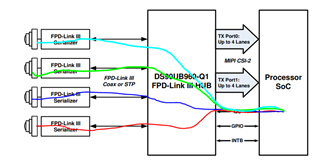Hi Team,
When trying to communicate to multiple cameras over the backchannel, how should the datarate be calculated starting from the SoC?
Basically, all the data will have to share the same I2C pipe between the SoC and the DES, but then after that, it gets fanned out to the different backchannels, correct? So how does the math work out there to calculate how long communication could potentially take?

Thank you,
Jared

